The 3D Density Structure of the South China Sea Based on Wavelet Multi-Scale Analysis of Gravity Data and Its Tectonic Implications
Abstract
1. Introduction
2. Methods
2.1. Improved Parker Method
2.2. Wavelet Multi-Scale Separation
2.3. Estimation of the Average Field Source Depth
2.4. Layered Density Inversion
3. Data
3.1. Bouguer Gravity Anomaly
3.2. Sediment-Free Gravity Anomaly
4. Results
4.1. Wavelet Detail Gravity Anomalies
4.2. Layered Density Anomaly
4.3. Gravity Anomalies of the Crust and Upper Mantle
4.4. Density Anomalies of the Crust and Upper Mantle
5. Discussion
5.1. Comparison with Previous Models
5.2. Density Variations in the COT
5.3. The Manila Trench and Luzon Island
5.4. The Expansion of the SCS
6. Conclusions
Author Contributions
Funding
Data Availability Statement
Acknowledgments
Conflicts of Interest
References
- Tozer, B.; Sandwell, D.T.; Smith, W.H.F.; Olson, C.; Beale, J.R.; Wessel, P. Global Bathymetry and Topography at 15 Arc Sec: SRTM15+. Earth Space Sci. 2019, 6, 1847–1864. [Google Scholar] [CrossRef]
- Yu, H.; Xu, C.; Chen, H.; Chai, Y.; Qin, P.; Wang, G.; Zhang, H.; Xu, M.; Xing, C.; Wang, H. Multilayer Densities of the Crust and Upper Mantle in the South China Sea Using Gravity Multiscale Analysis. Remote Sens. 2023, 15, 3274. [Google Scholar] [CrossRef]
- Chen, H.; Li, Z.; Luo, Z.; Ojo, A.O.; Xie, J.; Bao, F.; Wang, L.; Tu, G. Crust and Upper Mantle Structure of the South China Sea and Adjacent Areas from the Joint Inversion of Ambient Noise and Earthquake Surface Wave Dispersions. Geochem. Geophys. Geosyst. 2021, 22, e2020GC009356. [Google Scholar] [CrossRef]
- Ben-Avraham, Z.; Uyeda, S. The Evolution of the China Basin and the Mesozoic Paleogeography of Borneo. Earth Planet. Sci. Lett. 1973, 18, 365–376. [Google Scholar] [CrossRef]
- Briais, A.; Patriat, P.; Tapponnier, P. Updated Interpretation of Magnetic Anomalies and Seafloor Spreading Stages in the South China Sea: Implications for the Tertiary Tectonics of Southeast Asia. J. Geophys. Res. Solid Earth 1993, 98, 6299–6328. [Google Scholar] [CrossRef]
- Flower, M.; Tamaki, K.; Hoang, N. Mantle Extrusion: A Model for Dispersed Volcanism and DUPAL-like Asthenosphere in East Asia and the Western Pacific. Mantle Dyn. Plate Interact. East Asia 1998, 27, 67–88. [Google Scholar]
- Hall, R. Cenozoic Geological and Plate Tectonic Evolution of SE Asia and the SW Pacific: Computer-Based Reconstructions, Model and Animations. J. Asian Earth Sci. 2002, 20, 353–431. [Google Scholar] [CrossRef]
- Holloway, N. North Palawan Block, Philippines—Its Relation to Asian Mainland and Role in Evolution of South China Sea. AAPG Bull. 1982, 66, 1355–1383. [Google Scholar] [CrossRef]
- Karig, D.E. Origin and Development of Marginal Basins in the Western Pacific. J. Geophys. Res. (1896–1977) 1971, 76, 2542–2561. [Google Scholar] [CrossRef]
- Tapponnier, P.; Peltzer, G.; Le Dain, A.; Armijo, R.; Cobbold, P. Propagating Extrusion Tectonics in Asia: New Insights from Simple Experiments with Plasticine. Geology 1982, 10, 611–616. [Google Scholar] [CrossRef]
- Zhang, G.; Jia, Q.; Wang, W.; Wang, P.; Zhao, Q.; Sun, X.; Xie, X.; Zhao, Z.; Tang, W. On tectonic framework and evolution of the South China Sea. Chin. J. Geophys. 2018, 61, 4194–4215. (In Chinese) [Google Scholar] [CrossRef]
- Wang, P.; Huang, C.-Y.; Lin, J.; Jian, Z.; Sun, Z.; Zhao, M. The South China Sea Is Not a Mini-Atlantic: Plate-Edge Rifting vs Intra-Plate Rifting. Natl. Sci. Rev. 2019, 6, 902–913. [Google Scholar] [CrossRef] [PubMed]
- Li, J.; Xu, C.; Chen, H. An Improved Method to Moho Depth Recovery from Gravity Disturbance and Its Application in the South China Sea. JGR Solid Earth 2022, 127, e2022JB024536. [Google Scholar] [CrossRef]
- Zhang, J.; Yang, G.; Tan, H.; Wu, G.; Wang, J. Mapping the Moho Depth and Ocean-Continent Transition in the South China Sea Using Gravity Inversion. J. Asian Earth Sci. 2021, 218, 104864. [Google Scholar] [CrossRef]
- Li, H.; Wu, Z.; Ji, F.; Gao, J.; Yang, C.; Yuan, Y.; Xu, M.; Zhang, J. Crustal density structure of the northern South China Sea from constrained 3-D gravity inversion. Chin. J. Geophys. 2020, 63, 1894–1912. (In Chinese) [Google Scholar] [CrossRef]
- Ma, G.; Niu, Y.; Li, L.; Li, Z.; Meng, Q. Adaptive Space–Location-Weighting Function Method for High-Precision Density Inversion of Gravity Data. Remote Sens. 2023, 15, 5737. [Google Scholar] [CrossRef]
- Yu, H.; Wang, G.; Xu, C.; Chai, Y.; Bie, L.; Cui, L. Insight into Three-Dimensional Structure of the Lunar Crust and Upper Mantle in the Mare Crisium from Gravity Imaging. Adv. Space Res. 2024, 74, 1378–1391. [Google Scholar] [CrossRef]
- Li, C.; Gong, W.; Zhao, L.; Li, Z.; Zhi, P.; Ge, J. Gravity-Seismic Joint Inversion of Lithospheric Density Structure in the Qiongdongnan Basin, Northwest South China Sea. Lithosphere 2024, 2024, lithosphere_2023_124. [Google Scholar] [CrossRef]
- Yin, X.; Yao, C.; Wang, J.; Xu, W.; Zheng, Y.; Li, Z.; Mu, W. A Constrained 3D Gravity Inversion for Complex Density Distributions: Application to Brazil Rifted Continental Margin. Tectonophysics 2024, 874, 230236. [Google Scholar] [CrossRef]
- Li, J.; Wu, G.; Xu, C.; Chen, H.; Yan, J.; Zhang, X. Influence of gravity stripping in the South China Sea area on Moho inversion. Prog. Geophys. 2023, 38, 31–46. [Google Scholar] [CrossRef]
- Parker, R.L. The Rapid Calculation of Potential Anomalies. Geophys. J. Int. 1973, 31, 447–455. [Google Scholar] [CrossRef]
- Wu, L. Efficient Modelling of Gravity Effects Due to Topographic Masses Using the Gauss–FFT Method. Geophys. J. Int. 2016, 205, 160–178. [Google Scholar] [CrossRef]
- Yu, C.; Zhao, J.; Shi, X.; Yang, X.; Ren, Z.; Chen, M. Sediment density correction of gravity anomaly in the South China Sea and its significance to analyze regional tectonic characteristics. Chin. J. Geophys. 2017, 60, 3151–3166. (In Chinese) [Google Scholar] [CrossRef]
- Mallat, S.G. A Theory for Multiresolution Signal Decomposition: The Wavelet Representation. IEEE Trans. Pattern Anal. Mach. Intell. 1989, 11, 674–693. [Google Scholar] [CrossRef]
- Spector, A.; Grant, F. Statistical Models for Interpreting Aeromagnetic Data. Geophysics 1970, 35, 293–302. [Google Scholar] [CrossRef]
- Heck, B.; Seitz, K. A Comparison of the Tesseroid, Prism and Point-Mass Approaches for Mass Reductions in Gravity Field Modelling. J. Geod. 2007, 81, 121–136. [Google Scholar] [CrossRef]
- Tikhonov, A.N.; Arsenin, V.Y. Solutions of Ill-Posed Problems; Winston: New York, NY, USA, 1977; Volume 32. [Google Scholar] [CrossRef]
- Balmino, G.; Vales, N.; Bonvalot, S.; Briais, A. Spherical harmonic modelling to ultra-high degree of Bouguer and isostatic anomalies. J. Geod. 2012, 86, 499–520. [Google Scholar] [CrossRef]
- Zhao, Q.; She, Y.; Fu, G. Gravity Anomalies and Lithospheric Flexure in Western Yunnan, China, Deduced from a New Dense Gravimetry. Geophys. Res. Lett. 2021, 48, e2021GL095313. [Google Scholar] [CrossRef]
- Qiu, N.; Yao, Y.; Zhang, J.; Wang, L.; Xu, D. Characteristics of the crustal structure and its tectonic significance of the continental margin of SE South China Sea. Chin. J. Geophys. 2019, 62, 2607–2621. (In Chinese) [Google Scholar] [CrossRef]
- Bird, P. An Updated Digital Model of Plate Boundaries. Geochem. Geophys. Geosyst. 2003, 4, 1027. [Google Scholar] [CrossRef]
- Whittaker, J.M.; Goncharov, A.; Williams, S.E.; Müller, R.D.; Leitchenkov, G. Global Sediment Thickness Data Set Updated for the Australian-Antarctic Southern Ocean. Geochem. Geophys. Geosyst. 2013, 14, 3297–3305. [Google Scholar] [CrossRef]
- Xu, C.; Jian, G.; Cui, L. Three-Dimensional Moho Topography beneath the Tibetan Plateau Determined by Γxy, Γxz and Γyz of GOCE Gravity Gradients. J. Asian Earth Sci. 2023, 256, 105822. [Google Scholar] [CrossRef]
- Liu, J.; Li, S.; Cao, X.; Dong, H.; Suo, Y.; Jiang, Z.; Zhou, J.; Li, X.; Zhang, R.; Liu, L.; et al. Back-Arc Tectonics and Plate Reconstruction of the Philippine Sea-South China Sea Region Since the Eocene. Geophys. Res. Lett. 2023, 50, e2022GL102154. [Google Scholar] [CrossRef]
- Kustowski, B.; Ekström, G.; Dziewoński, A.M. Anisotropic Shear-Wave Velocity Structure of the Earth’s Mantle: A Global Model. J. Geophys. Res. Solid Earth 2008, 113, B6. [Google Scholar] [CrossRef]
- Liu, W.; Gai, C.; Feng, W.; Cao, W.; Guo, L.; Zhong, Y.; Liu, J.; Zhou, Y.; Chou, Y.; Lin, J.; et al. Coeval Evolution of the Eastern Philippine Sea Plate and the South China Sea in the Early Miocene: Paleomagnetic and Provenance Constraints from ODP Site 1177. Geophys. Res. Lett. 2021, 48, e2021GL093916. [Google Scholar] [CrossRef]
- Armada, L.T.; Hsu, S.-K.; Dimalanta, C.B.; Yumul, G.P., Jr.; Doo, W.-B.; Yeh, Y.-C. Forearc Structures and Deformation along the Manila Trench. J. Asian Earth Sci. X 2020, 4, 100036. [Google Scholar] [CrossRef]
- Liu, W.; Zhao, X.; Lin, J.; Zhao, M.; Liu, Q. Discussion on the co-evolution of the Philippine Sea Plate and the South China Sea. Chin. J. Geophys. 2022, 65, 3521–3539. (In Chinese) [Google Scholar] [CrossRef]
- Yu, H.; Qin, P.; Xu, C.; Zhang, H.; Chai, Y.; Du, R. Improved Parker-Oldenburg Method and Its Application to Moho Topographic Inversion in the Northern South China Sea. Geophys. J. Int. 2024, 238, ggae224. [Google Scholar] [CrossRef]
- Li, Y.; Grevemeyer, I.; Huang, H.; Qiu, X.; Xu, Z. Seismic Constraint from Vp/Vs Ratios on the Structure and Composition Across the Continent-Ocean Transition Zone, South China Sea. Geophys. Res. Lett. 2021, 48, e2021GL094656. [Google Scholar] [CrossRef]
- Yang, X.; Shen, C.; Zhu, Y.; Yang, G.; Sun, K.; Tan, H.; Wang, J. Study on gravity inversion of three-dimensional density structure of the crust in Tangshan MS7.8 earthquake area. Chin. J. Geophys. 2023, 66, 183–196. (In Chinese) [Google Scholar] [CrossRef]
- Laske, G.; Masters, G.; Ma, Z.; Pasyanos, M. Update on CRUST1. 0—A 1-Degree Global Model of Earth’s Crust. Geophys. Res. Abstr. 2013, 15, 2658. [Google Scholar]
- Yumul Jr, G.P.; Dimalanta, C.B.; Tamayo, R.A., Jr.; Maury, R.C. Collision, Subduction and Accretion Events in the Philippines: A Synthesis. Isl. Arc 2003, 12, 77–91. [Google Scholar] [CrossRef]
- Zhang, J.; Sun, Z.; Yang, H.; Zhang, F. A Model of Plate Bending at the Transition Zone from Subduction to Collision in Northernmost Manila Trench. Geophys. Res. Lett. 2022, 49, e2022GL100474. [Google Scholar] [CrossRef]
- Yao, B. Tectonic Evolution of the South China Sea in Cenozoic. Mar. Geol. Quat. Geol. 1996, 16, 13–20. (In Chinese) [Google Scholar]
- Cheng, L.; Fang, Y.; Niu, X.; Li, T.; Dong, C.; Zhao, Y.; Hu, H.; Kong, F.; Tan, P.; Ruan, A.; et al. Lithospheric Velocity Structure of South China Sea Basin from Ocean Bottom Seismometer Ambient Noise Tomography. Tectonophysics 2023, 864, 230008. [Google Scholar] [CrossRef]
- Wessel, P.; Smith, W.H. New, improved version of Generic Mapping Tools released. Eos Trans. Am. Geophys. Union 1998, 79, 579. [Google Scholar] [CrossRef]
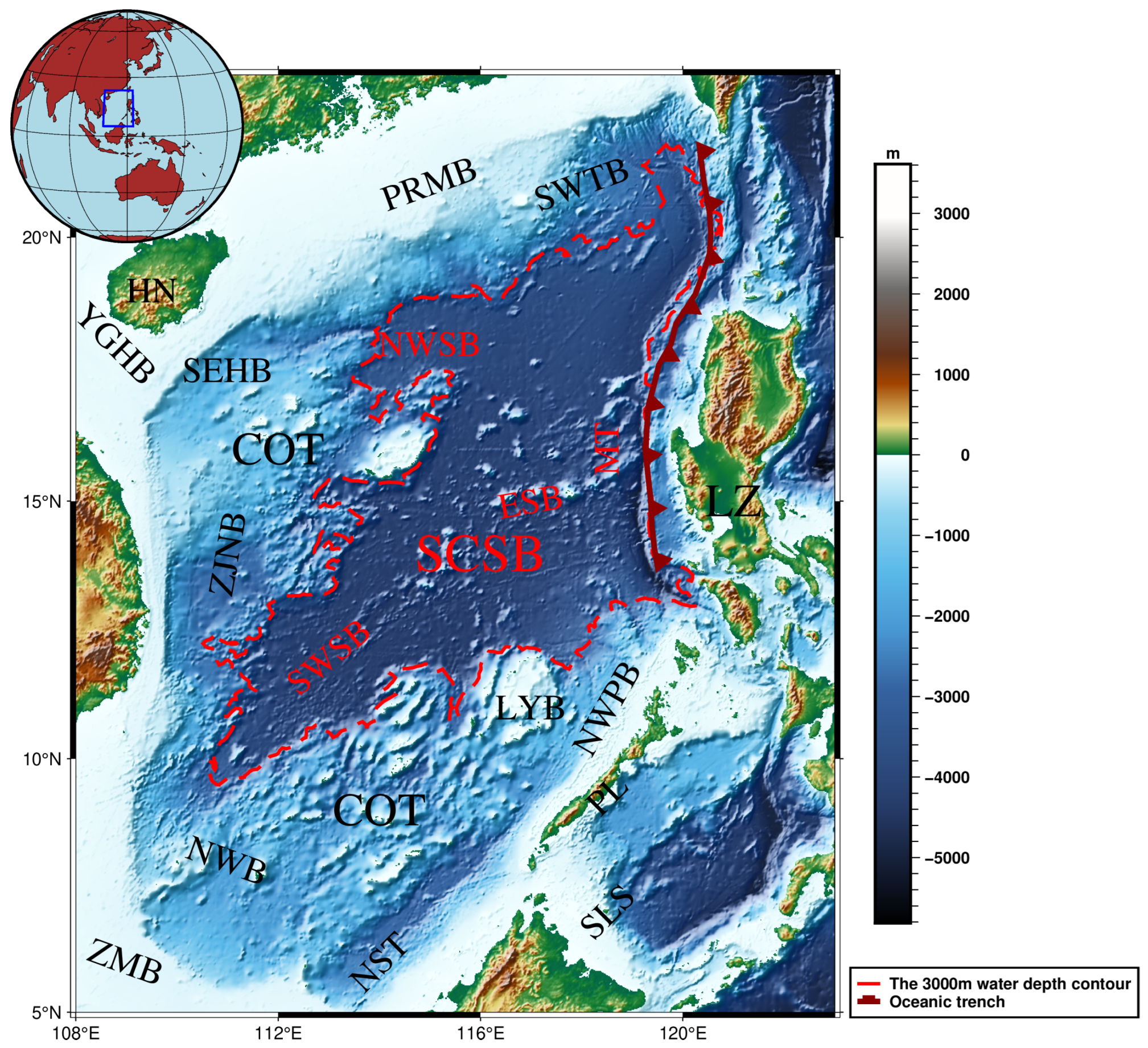
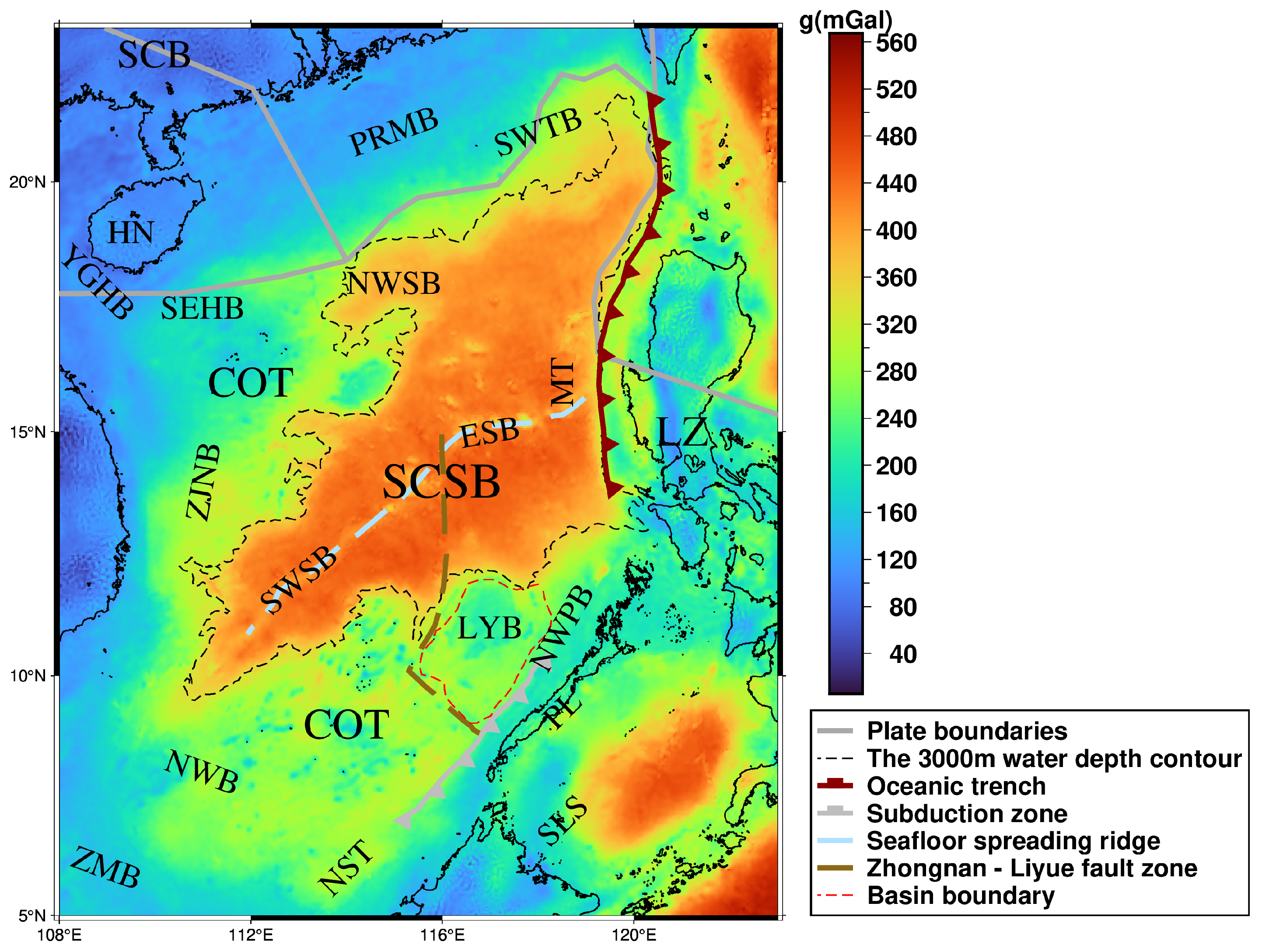
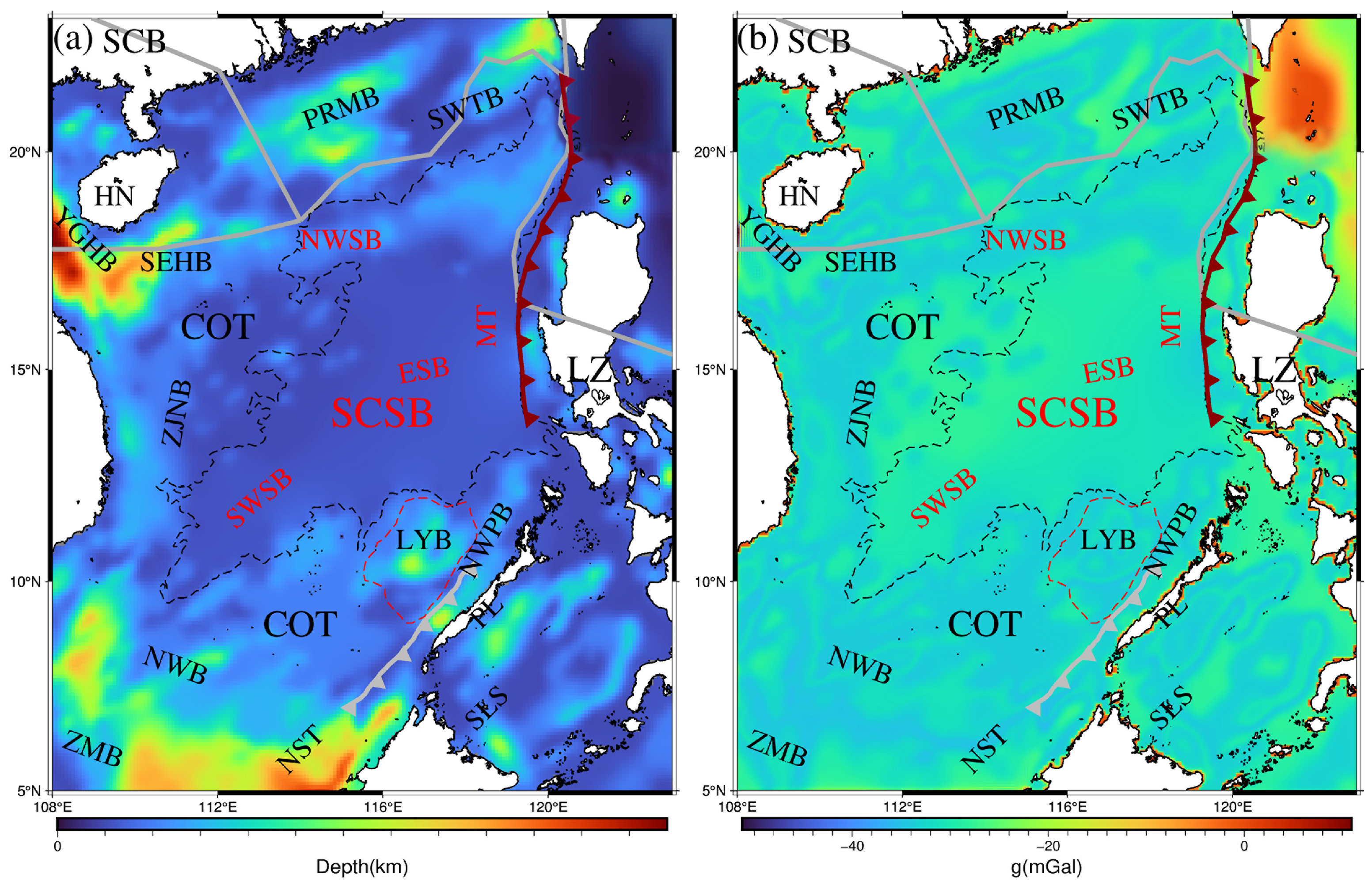
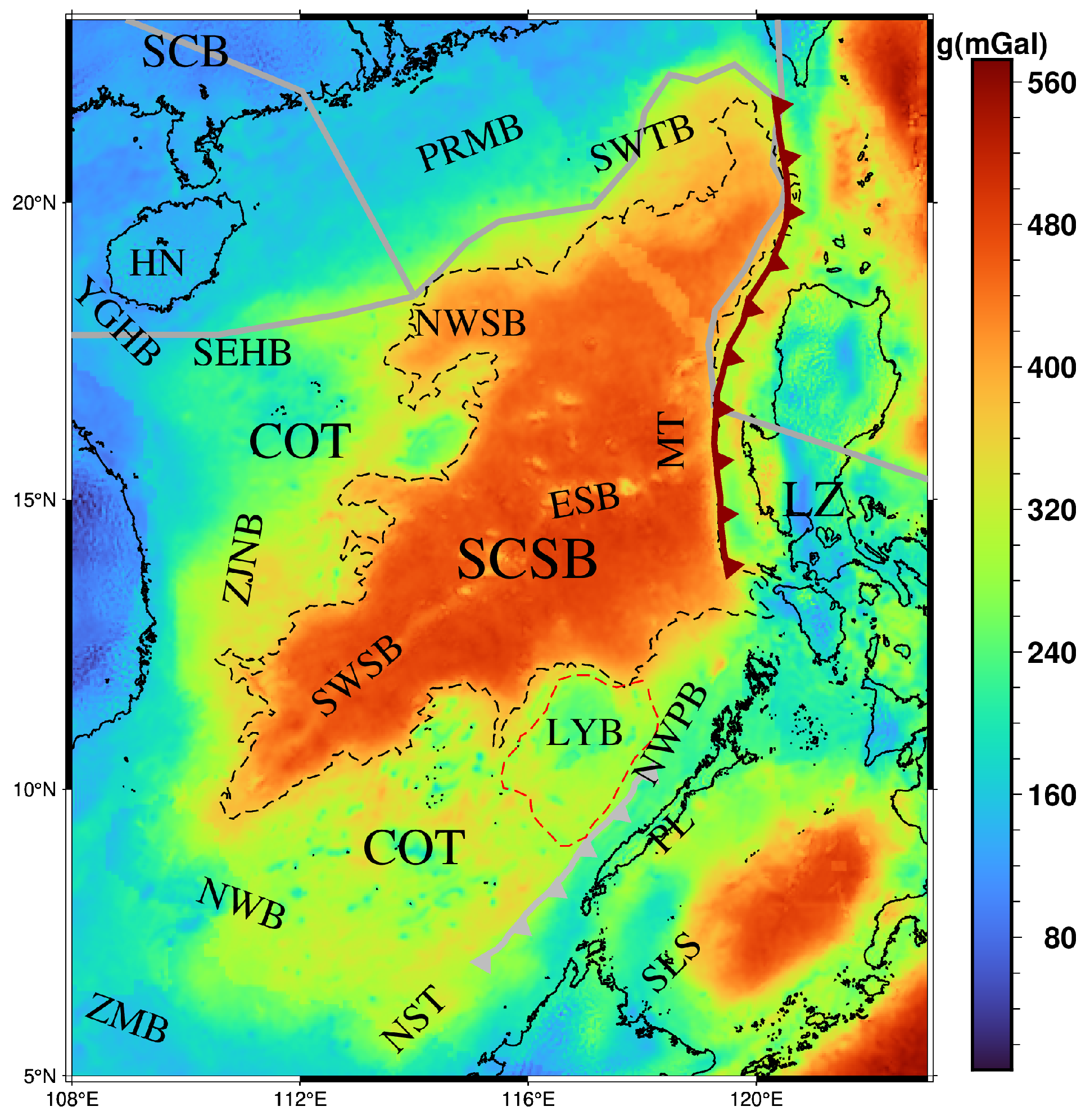
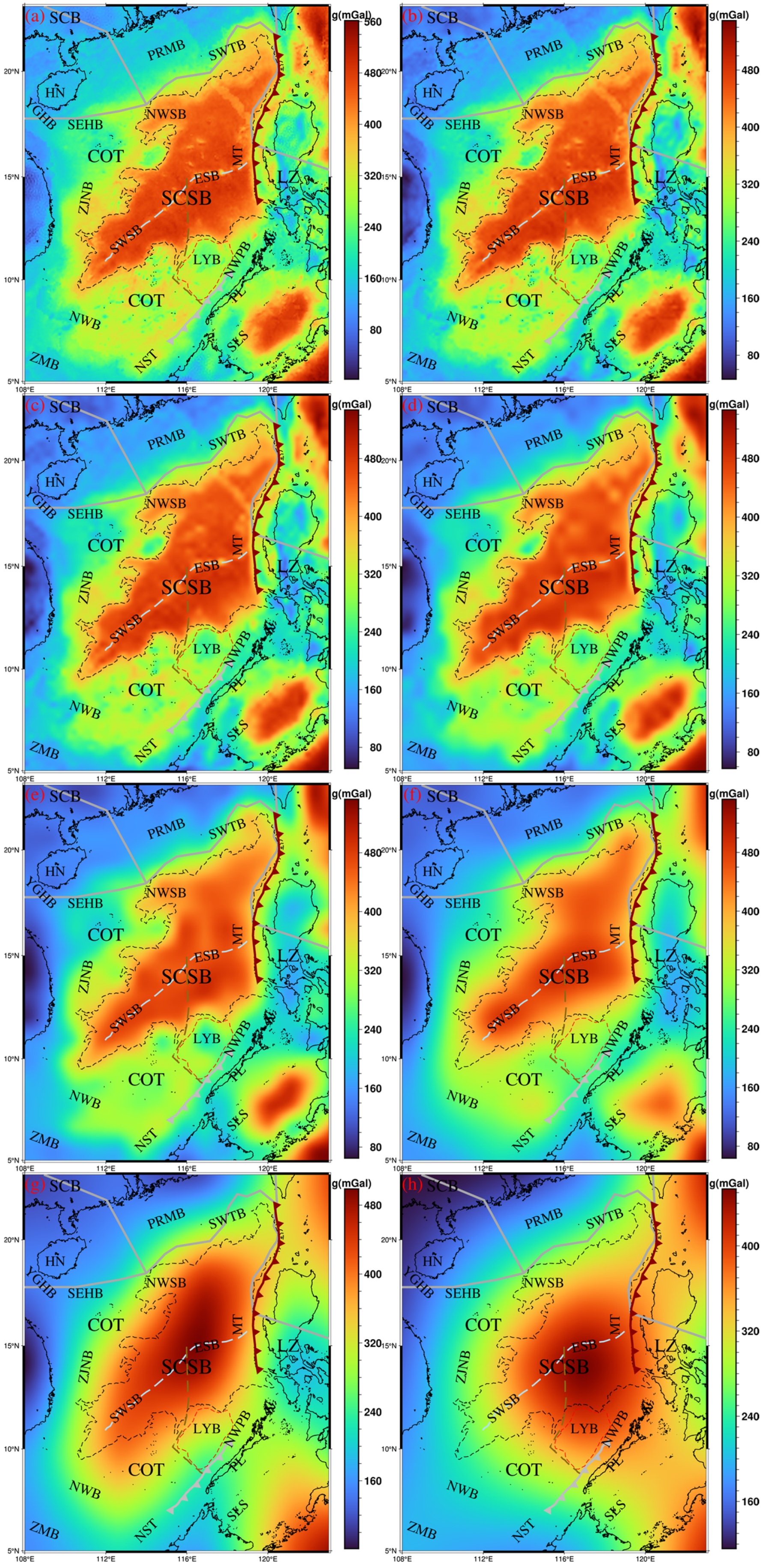

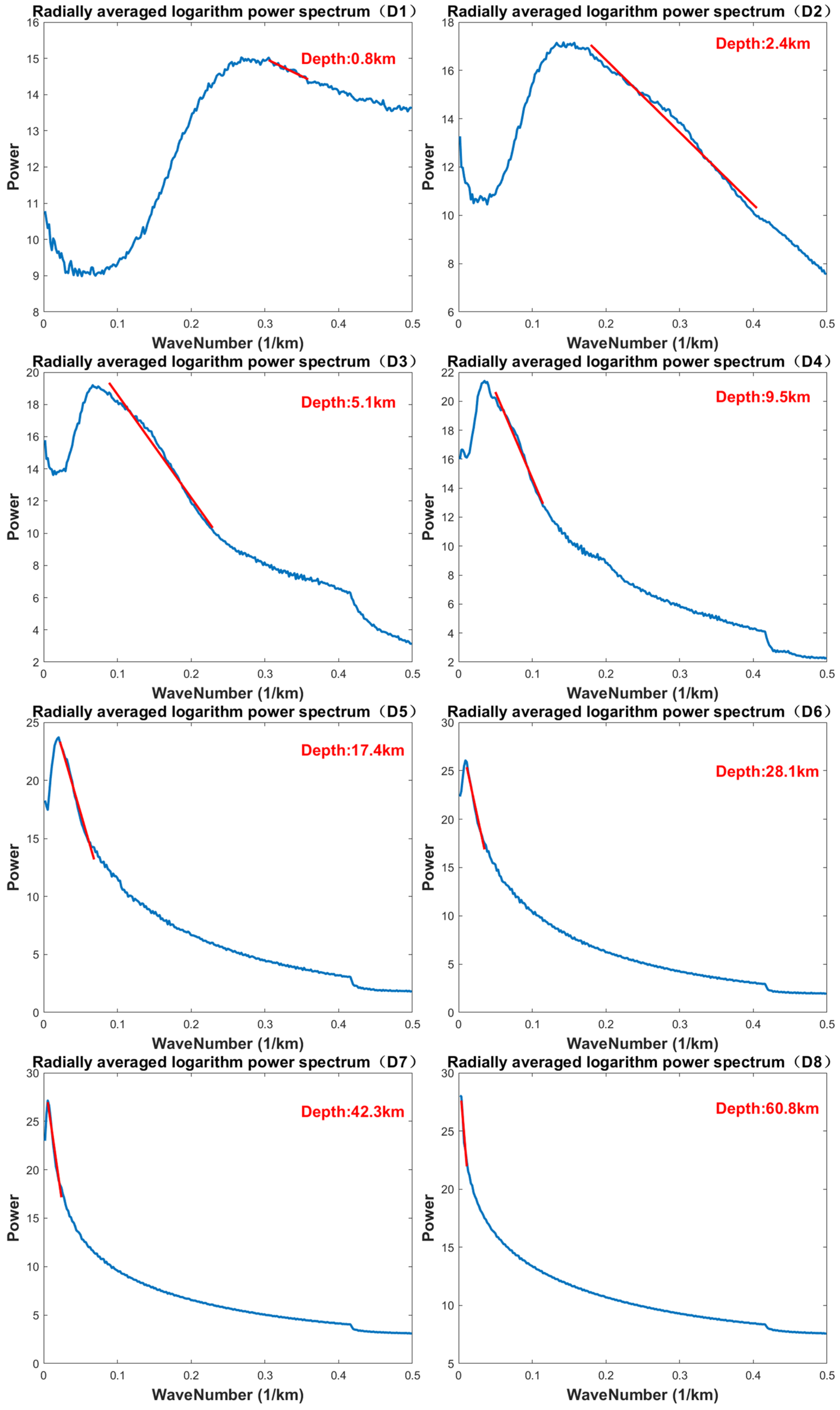

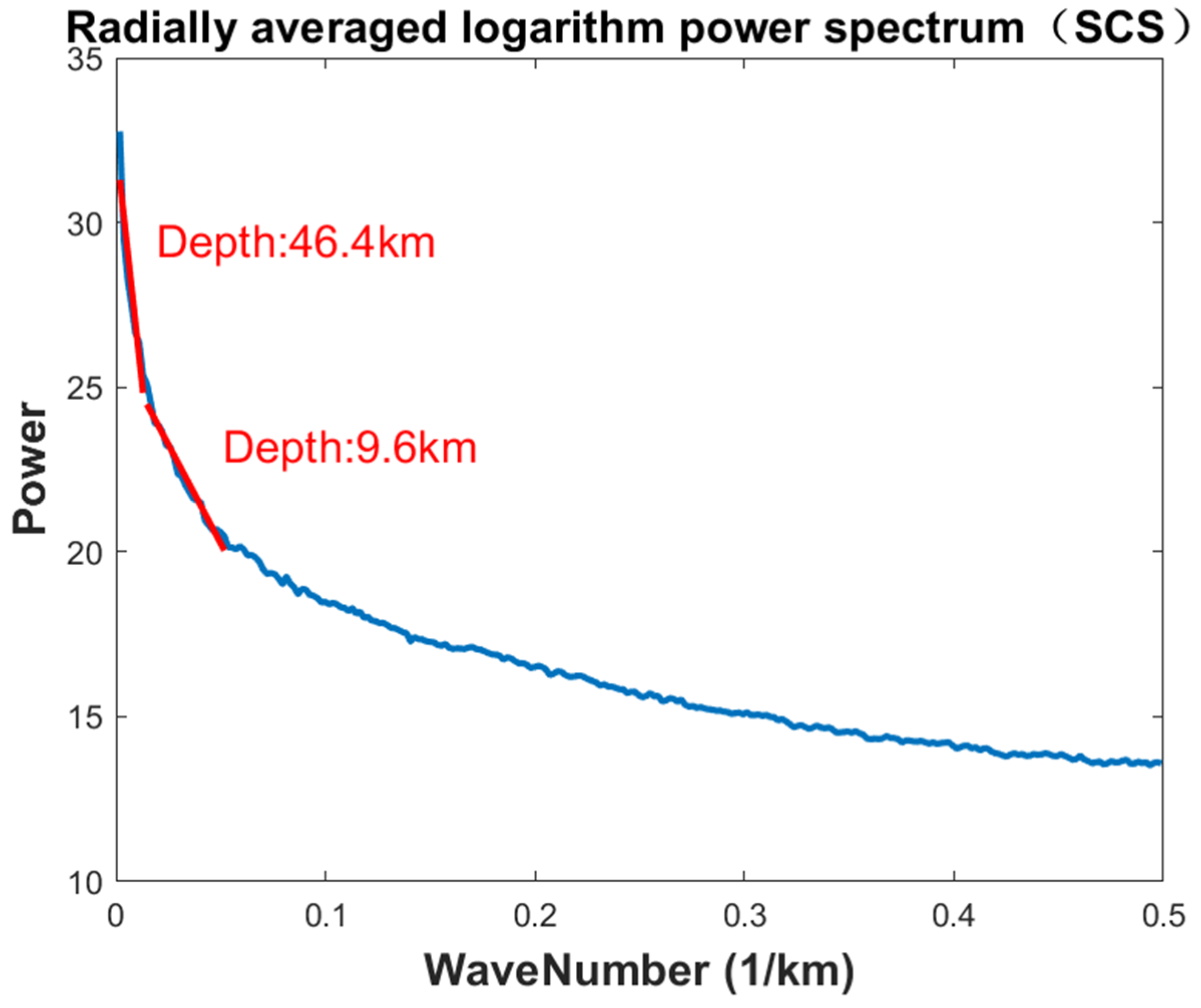




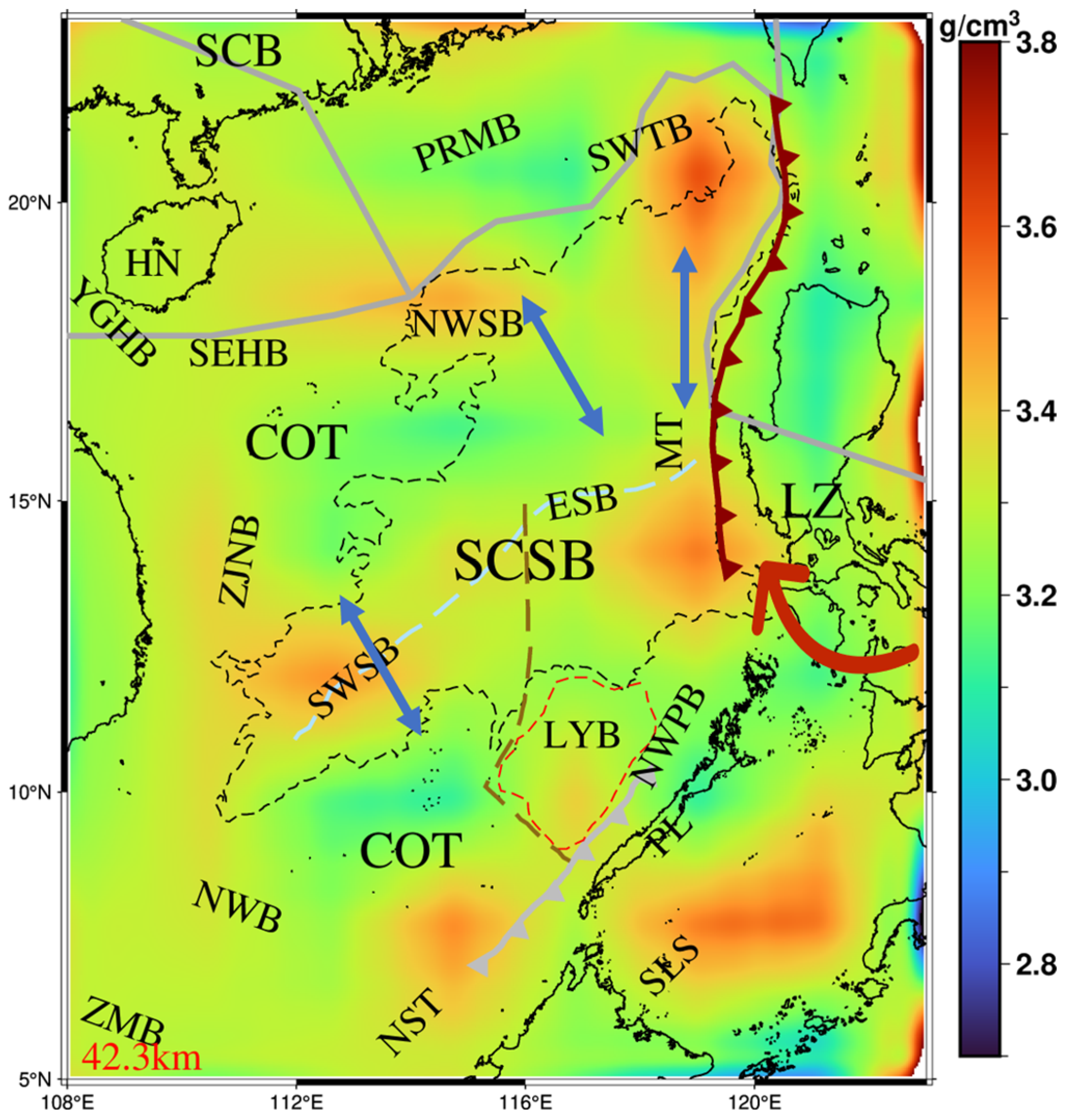
| Number of Layers | Depth Range (km) | Average Field Source Depth (km) | Thickness (km) |
|---|---|---|---|
| 1 | 0.0~1.6 | 0.8 | 1.6 |
| 2 | 1.6~3.2 | 2.4 | 1.6 |
| 3 | 3.2~7.0 | 5.1 | 3.8 |
| 4 | 7.0~12.0 | 9.5 | 5.0 |
| 5 | 12.0~22.8 | 17.4 | 10.8 |
| 6 | 22.8~33.4 | 28.1 | 10.6 |
| 7 | 33.4~51.2 | 42.3 | 17.8 |
| 8 | 51.2~70.4 | 60.8 | 19.2 |
| Number of layers | 3 | 4 | 5 | 6 | 7 | 8 |
| Average density value (g/cm3) | 2.60 | 2.66 | 2.90 | 3.06 | 3.30 | 3.31 |
| Depth Range (km) | Average Field Source Depth (km) | Thickness (km) | |
|---|---|---|---|
| Shallow anomaly signal | 0.0~19.2 | 9.6 | 19.2 |
| Deep anomaly signal | 19.2~73.6 | 46.4 | 54.4 |
| Depth Range (km) | Average Field Source Depth (km) | Thickness (km) | |
|---|---|---|---|
| Crust anomaly | 3.2~22.8 | 13.0 | 19.6 |
| Upper-mantle anomaly | 22.8~70.4 | 46.6 | 47.6 |
| Crust Anomaly | Upper-Mantle Anomaly | |
|---|---|---|
| Average density value (g/cm3) | 2.75 | 3.23 |
Disclaimer/Publisher’s Note: The statements, opinions and data contained in all publications are solely those of the individual author(s) and contributor(s) and not of MDPI and/or the editor(s). MDPI and/or the editor(s) disclaim responsibility for any injury to people or property resulting from any ideas, methods, instructions or products referred to in the content. |
© 2024 by the authors. Licensee MDPI, Basel, Switzerland. This article is an open access article distributed under the terms and conditions of the Creative Commons Attribution (CC BY) license (https://creativecommons.org/licenses/by/4.0/).
Share and Cite
Xu, C.; Su, S.; Chen, H.; Yu, H.; Li, J.; Zhang, F.; Liang, J.; Lin, X. The 3D Density Structure of the South China Sea Based on Wavelet Multi-Scale Analysis of Gravity Data and Its Tectonic Implications. Remote Sens. 2024, 16, 3675. https://doi.org/10.3390/rs16193675
Xu C, Su S, Chen H, Yu H, Li J, Zhang F, Liang J, Lin X. The 3D Density Structure of the South China Sea Based on Wavelet Multi-Scale Analysis of Gravity Data and Its Tectonic Implications. Remote Sensing. 2024; 16(19):3675. https://doi.org/10.3390/rs16193675
Chicago/Turabian StyleXu, Chuang, Shiquan Su, Haopeng Chen, Hangtao Yu, Jinbo Li, Feiyu Zhang, Juntao Liang, and Xu Lin. 2024. "The 3D Density Structure of the South China Sea Based on Wavelet Multi-Scale Analysis of Gravity Data and Its Tectonic Implications" Remote Sensing 16, no. 19: 3675. https://doi.org/10.3390/rs16193675
APA StyleXu, C., Su, S., Chen, H., Yu, H., Li, J., Zhang, F., Liang, J., & Lin, X. (2024). The 3D Density Structure of the South China Sea Based on Wavelet Multi-Scale Analysis of Gravity Data and Its Tectonic Implications. Remote Sensing, 16(19), 3675. https://doi.org/10.3390/rs16193675









